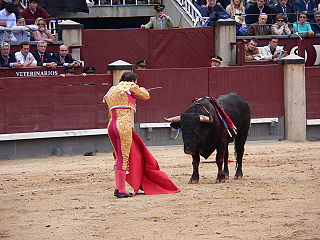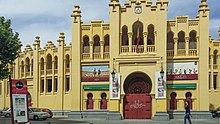
A running of the bulls is an event that involves running in front of a small group of bulls, typically six but sometimes ten or more, that have been let loose on sectioned-off streets in a town, usually as part of a summertime festival. Particular breeds of cattle may be favored, such as the toro bravo in Spain, also often used in post-run bullfighting, and Camargue cattle in Occitan France, which are not fought. Bulls are typically used in such events.

Albacete is a city and municipality in the Spanish autonomous community of Castilla–La Mancha, and capital of the province of Albacete.

A bullring is an arena where bullfighting is performed. Bullrings are often associated with the Iberian Peninsula, but they can also be found through Iberian America and in a few Spanish and Portuguese ex-colonies in Africa. Bullrings are often historic and culturally significant centres that bear many structural similarities to the Roman amphitheatre.

The Plaza de Toros de Ronda is a Bullring in Ronda, it has a diameter of 66 metres (217 ft), surrounded by a passage formed by two rings of stone. There are two layers of seating, each with five raised rows and 136 pillars that make up 68 arches. The Royal Box has a sloping roof covered in Arabic tiles. The design of the main entrance to the bull ring features two Tuscan columns and the royal shield of Spain surround by baroque edging. The main door is large enough to allow horses and carriages to enter the ring, and above the door is an iron wrought balcony that embodies the bullfighting culture.

Antonio Ordóñez Araujo was a Spanish bullfighter.

The Plaza de Torosde Acho is the premier bullring in Lima, Peru. Located beside the historical center of the Rímac District, the plaza is classified as a national historic monument. It is the oldest bullring in the Americas and the second-oldest in the world after La Maestranza in Spain. It opened on 30 January 1766.

The Spanish Fighting Bull is an Iberian heterogeneous cattle population. It is exclusively bred free-range on extensive estates in Spain, Portugal, France and Latin American countries where bull fighting is organized. Fighting bulls are selected primarily for a certain combination of aggression, energy, strength and stamina. In order to preserve their natural traits, during breeding the bulls rarely encounter humans, and if so, never encounter them on foot.
The Plaza de toros Nuevo Progreso is a bullring in the Mexican city of Guadalajara, Jalisco. It is currently used for bull fighting and also for hosting musical events, and professional wrestling events. The bullring holds 16,561 people and was built in 1966 to 1967.

Bullfighting is a physical contest that involves a bullfighter attempting to subdue, immobilize, or kill a bull, usually according to a set of rules, guidelines, or cultural expectations.
Bullfighting was banned in the Spanish autonomous community of Catalonia by a vote of the Catalan Parliament in July 2010. The ban came into effect on January 1, 2012. The last bullfight in the region took place on 25 September 2011 at La Monumental. The ban was officially annulled for being unconstitutional by Spain's highest court on October 5, 2016. However, despite the overturning of the ban, no further bullfight had taken place in Catalonia as of July 2020.

The Royal Fair of Algeciras is the most important annual festival in the Spanish city of Algeciras, held in June each year. Since it was established in 1850 as a cattle market, the fair and the fairground in which it is held have become popular attractions for the people of Algeciras and the surrounding towns of the Campo de Gibraltar. It has moved several times since its establishment and is now held in the Las Colinas area, where Algeciras's Las Palomas bullring is also located.

La Tauromaquia (Bullfighting) is a series of 33 prints created by the Spanish painter and printmaker Francisco Goya, which was published in 1816. The works of the series depict bullfighting scenes. There are also seven extra prints that were not published in the original edition.

Plaza de toros de las Arenas was a bullring in Barcelona, Catalonia, Spain. Over the years it featured numerous musical artists, including Carlos Santana and Paco de Lucia in 1977. It opened on June 29, 1900, and its last bullfight was held on June 19, 1977. The building was reopened in 2011 as a shopping mall named Arenas de Barcelona.

La Malagueta is a bullring at Málaga, Andalucía, Spain which since 1876 has been denominated a cultural asset of Spain (BIC). It is located in the eastern district of Málaga, alongside the Paseo de Reding.
Dámaso González Carrasco was a Spanish bullfighter.

Hilda Eliana Tenorio Patiño is a Mexican bullfighter and matador. She was the first woman to receive her alternativa in the Plaza de Toros México, the largest bullring in the world, aged 24. Tenorio completed her alternativa on February 28, 2010. She has been an outspoken advocate of feminism in the sport. She is the third Mexican woman to attain the rank of matador.
Juan José García Corral, was a Spanish bullfighter and director of the Escuela Tauromaquia of Salamanca
Pablo Lozano Martín, commonly known as La Muleta de Castilla, was a Spanish bullfighter and fighting bull cattle rancher, owner of cattle raising Alcurrucén and "Hermanos Lozano".

The Plaza de Toros de Pontevedra (Spain) is the bullring of the Spanish city of Pontevedra and the only one in the autonomous community of Galicia. It has a capacity of 7,800 spectators and is classified as the second category of Spanish bullring. The current bullring replaced a wooden one dating from 1892, although the tradition of bullfighting in Pontevedra dates back to the 17th century.

José Gallego Mateo, known as Pepete III, was a Spanish matador.















